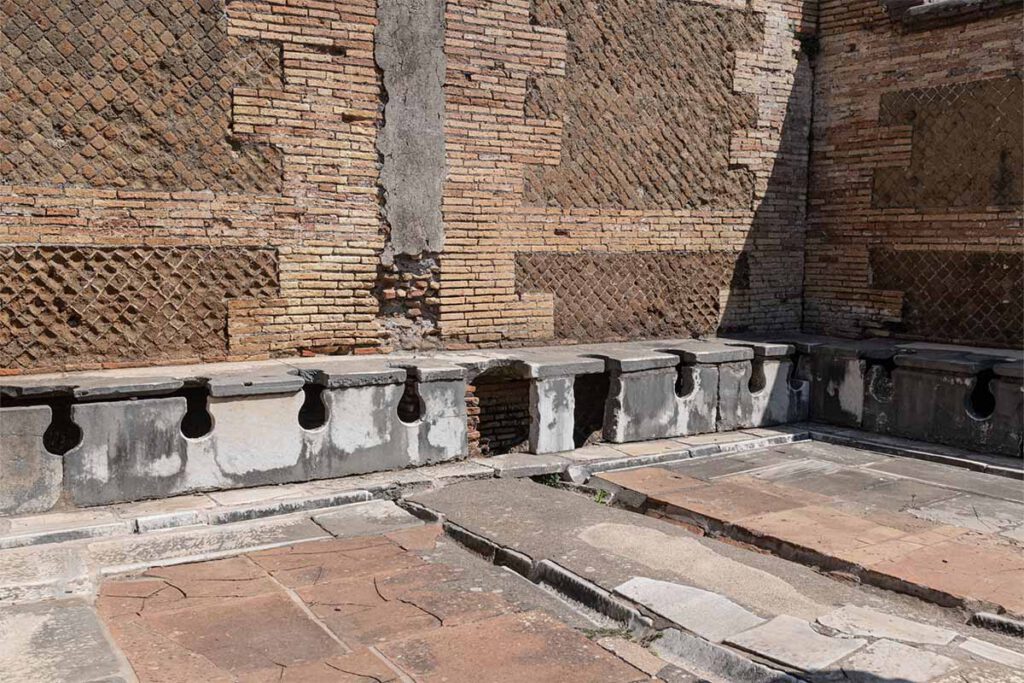Overview
RFA Staff
While modern technology has brought us great inventions, how often do we think about the advancements in the bathroom? We haven’t always had the luxuries of running water, private restrooms, and toilet paper. Throughout civilization there have been different definitions of what we would refer to as a toilet. From Ancient Egypt to the Middle Ages, different methods were used to take care of business. What could have been flushed down the toilets of times past?
Ancient Egypt —Before 3100 BC
The first time we see what might resemble a bathroom came about in Ancient Egypt, before the first pharaoh, Menes. The wealthy had separate rooms that provided privacy, while the other classes made do with the resources and land they had. There wasn’t running water quite yet, so toilets were seats with a hole cut out, leading to a container filled with sand.
The seats could be made of anything from limestone to wooden stools. But all the containers were handled the same way: waste was dumped into the Nile River, mixing with the same water used for drinking, bathing, and cooking. Thank goodness for water sanitation today! While toilets didn’t necessarily have proper plumbing, some wealthy citizens had wet rooms that contained a drain and pipes made of straw and clay.
The Verdict: It seems that the only thing that belongs in these toilets is number one and two. Anything else would create litter in one of the world’s most important waterways. Even as time progressed to create drains around the first cities, pipes made of straw and clay wouldn’t withstand even the smallest ply toilet paper, let alone non-flushable wet wipes and paper towels.
The Romans —753 BC to 476 AD
Next up on our travels through time is the Roman Empire. We all know the Romans’ love of Greek imitation, but the aqueducts wouldn’t come around until the turn of the first century. Still, public toilets—known as foricae—now had the luxury of running water. Unfortunately, privacy was still not accessible. Instead, there were long benches with holes cut out, leading to running water below. Instead of toilet paper, they used sponges on sticks known as tersorium or small stones.
The running water came from pipes made from lead or plumbum. This is where we get the English word for plumber today! Eventually, these pipes would connect to drains for sewage and storm surges, with wealthy homes having direct connections. By the turn of the century, these drains connected to 11 aqueducts, creating a water system still used today.
The Verdict: The power of flowing water is huge! If these sewer systems could handle stones, surely, they could handle a few squares of toilet paper. We still wouldn’t recommend baby wipes or cotton balls – you would be surprised with how quickly these items clog pipes and how slow they break down.
The Middle Ages and Victorian Era — 500 AD to 1901 AD
None other than the godson of Queen Elizabeth I wrote about the first flushable toilet. Sir John Harrington installed his masterpiece in Richmond Palace in 1596. He described this throne as an oblong bowl that could be flushed with 7.5 gallons of water and was made waterproof with pitch, resin, and wax. However, widespread use wouldn’t come until the 1800s.
In the meantime, the Middle Ages brought about the Garderobe. This was a private room inside a castle, situated at the top of a tower on the exterior walls. Waste was disposed of using gravity and acted as a defense mechanism against invaders – either on the ground or in moats.
The Verdict: These thrones were able to handle quite a lot, but we still would not recommend pouring grease down these shoots. Grease can cause fatbergs, large masses that clog up any sewage system and prevent waste from being properly disposed of, even with the help of gravity.
Modern Toilet — 1902 AD to Today
While rural areas were still developing the infrastructure for a proper sewage system, the early 1900s saw the widespread use of toilet paper. Clarence and E. Irvin Scott invented a type of soft tissue paper that fit on a cardboard roll, allowing for easy manufacturing and transportation.
Today we not only have running water, but incredible wastewater systems that allow us to flush and forget. We also have privacy in almost every bathroom, along with products to keep ourselves fresh and clean. Many advancements in technology allowed us to get here, but we still must be mindful of what we flush. Check out this list below to see what shouldn’t go down a modern toilet:
What Not to Flush:
• Baby Wipes or Household Cleaning Wipes
• Paper Towels, Facial Tissue, Plastic Bags
• Fats, Oils, and Grease
• Food, Trash
• Pads, Rags, Cloth, Disposable Gloves
• Cotton Balls, Cotton Swabs, Dental Floss
• Feminine Products
• Hair/Hair Weaves
• Medications/Syringes
With its #FlushSmart consumer education campaign, the Responsible Flushing Alliance is dedicated to keeping homes and communities healthy through proper flushing practices. This includes supporting clear and prominent labeling of all items that should not be flushed, including promotion of the “Do Not Flush” symbol on non-flushable wipes.
For more information, go to http://www.flushsmart.org or @flushsmart on Twitter or Facebook.
About Responsible Flushing Alliance
The Responsible Flushing Alliance (RFA) is a 501(c)(6) non-profit organization dedicated to consumer education focused on what should and should not be flushed. RFA’s goal is to change consumer behavior to help reduce damage to our nation’s sewage systems caused by objects and materials not designed to be flushed.
Responsible Flushing Alliance Coalition Members
Albaad, ANDRITZ, DUDE Products, Essity, First Quality, Johnson & Johnson, Glatfelter, Kelheim Fibres GmbH, Kimberly-Clark Corporation, Nehemiah Manufacturing, Nice-Pak, Papel Aramark S.A., Procter & Gamble, Rockline Industries, Sellars Nonwovens, and Suominen Corp.
